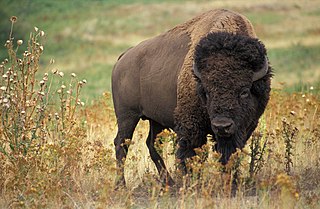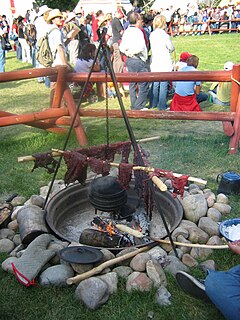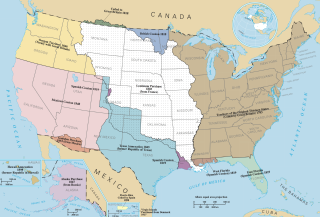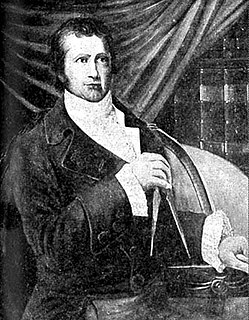Saleesh House, also known as Flathead Post, [1] was a North West Company fur trading post built near present-day Thompson Falls, Montana in 1809 by David Thompson and James McMillan of the North West Company. [2] It became a Hudson's Bay Company (HBC) post after that company absorbed the North West Company. Under HBC control the post was better known as Flathead rather than Saleesh. It continued to operate until at least 1855. [3]

The North West Company was a fur trading business headquartered in Montreal from 1779 to 1821. It competed with increasing success against the Hudson's Bay Company in what is present-day Western Canada. With great wealth at stake, tensions between the companies increased to the point where several minor armed skirmishes broke out, and the two companies were forced by the British government to merge.
"Factory" was the common name during the medieval and early modern eras for an entrepôt – which was essentially an early form of free-trade zone or transshipment point. At a factory, local inhabitants could interact with foreign merchants, often known as factors. First established in Europe, factories eventually spread to many other parts of the world.

Thompson Falls is a city in and the county seat of Sanders County, Montana, United States. The population was 1,313 at the 2010 census.
Thompson had established the post of Kullyspell House earlier in the year in the territory of the Pend d'Oreilles (who Thompson called the Kullyspel, an early variant spelling of "Kalispell"). This post was sited near the mouth of the Clark Fork river. By October Thompson had decided to established another post farther up the Clark Fork in the territory of the Flatheads. Thompson's name for the Flatheads was Saleesh. He also called Clark Fork the Saleesh River. The Saleesh House trading post was built by the end of 1809. [2]
Kullyspell House was a fur trading post established in 1809 on Lake Pend Oreille in what is now North Idaho. It was built by Finan McDonald under the direction of David Thompson of the North West Company.
The location of Saleesh House proved ideal, as it was on a route connecting the higher mountain country with bison hunting grounds near Flathead Lake. Several tribes used this route and traditionally encamped for winter near the Saleesh House site. The post quickly attracted a diverse community around itself. In addition, the region around the post was rich with beavers. The indigenous peoples had access to pemmican supplies and were willing to trap and trade beaver skins. The Saleesh House rapidly became the focal point of an impressively rich fur trading region in what would become Montana. [2]

Bison are large, even-toed ungulates in the genus Bison within the subfamily Bovinae.

Flathead Lake is a large natural lake in northwest Montana, and is the largest natural freshwater lake by surface area that is west of the source of the Mississippi River in the contiguous United States.

Pemmican is a concentrated mixture of fat and protein used as a nutritious food. Historically, it was an important part of Native American cuisine in certain parts of North America, and is still prepared today. The word comes from the Cree word pimîhkân, which itself is derived from the word pimî, "fat, grease". The Lakota word is wasna, with the wa meaning "anything" and the sna meaning "ground up". It was invented by the native peoples of North America.
It was at Saleesh House in late 1809 and early 1810 that David Thompson acquired the nickname Koo-koo-Sint, or "Star-Looker". [2]
In 1810 Thompson and other members of the North West Company linked Saleesh House with Spokane House via a trail known as the "Skeetshoo Indian Road". Thompson soon left and did not return to Saleesh House until 1812, where he found the post in poor condition. Thompson repaired and rebuilt the post more permanently. [4]
Spokane House was a fur-trading post founded in 1810 by the British-Canadian North West Company, located on a peninsula where the Spokane River and Little Spokane River meet. When established, it was the North West Company's farthest outpost in the Columbia River region. An American rival of the NWC, the Pacific Fur Company opened a station adjacent to Spokane House, called Fort Spokane. The War of 1812 and ongoing supply issues caused the collapse of the PFC, with its posts now under the control of the NWC. The original Spokane House was abandoned in favor of Fort Spokane, though the latter location was still called Spokane House. The second Spokane House saw use as a major post in the interior Oregon Country until the NWC was absorbed by the Hudson's Bay Company in 1821. During a general tour of the Pacific Northwest, Spokane House was abandoned by George Simpson in 1825, in favor of a new post that became Fort Colvile. The site of Spokane House is in Spokane County in the U.S. state of Washington, just northwest of the city of Spokane.
Joint British - U.S. occupation of areas west of the Rocky Mountains continental divide pursuant to the Treaty of 1818 ended with the Oregon Treaty which established the 49th parallel as the international boundary.

The Rocky Mountains, also known as the Rockies, are a major mountain range in western North America. The Rocky Mountains stretch more than 4,800 kilometers (3,000 mi) from the northernmost part of British Columbia, in western Canada, to New Mexico in the Southwestern United States. Located within the North American Cordillera, the Rockies are somewhat distinct from the Pacific Coast Ranges, Cascade Range, and the Sierra Nevada, which all lie farther to the west.
A continental divide is a drainage divide on a continent such that the drainage basin on one side of the divide feeds into one ocean or sea, and the basin on the other side either feeds into a different ocean or sea, or else is endorheic, not connected to the open sea.

The Convention respecting fisheries, boundary and the restoration of slaves between the United States of America and the United Kingdom of Great Britain and Ireland, also known as the London Convention, Anglo-American Convention of 1818, Convention of 1818, or simply the Treaty of 1818, was an international treaty signed in 1818 between the above parties. Signed during the presidency of James Monroe, it resolved standing boundary issues between the two nations. The treaty allowed for joint occupation and settlement of the Oregon Country, known to the British and in Canadian history as the Columbia District of the Hudson's Bay Company, and including the southern portion of its sister district New Caledonia.










